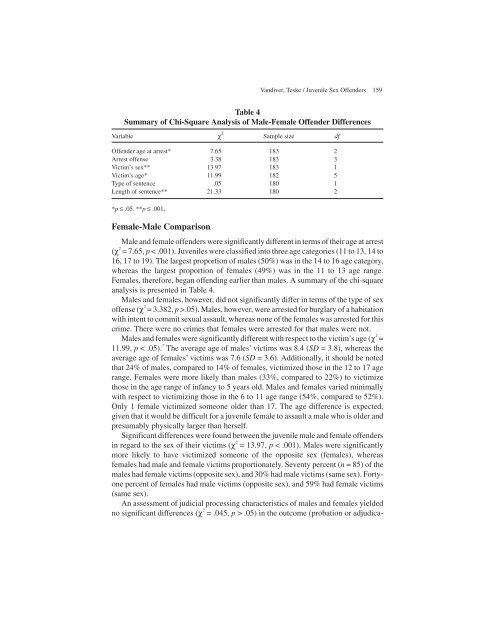Juvenile Female and Male Sex Offenders
Juvenile Female and Male Sex Offenders
Juvenile Female and Male Sex Offenders
You also want an ePaper? Increase the reach of your titles
YUMPU automatically turns print PDFs into web optimized ePapers that Google loves.
V<strong>and</strong>iver, Teske / <strong>Juvenile</strong> <strong>Sex</strong> <strong>Offenders</strong> 159Table 4Summary of Chi-Square Analysis of <strong>Male</strong>-<strong>Female</strong> Offender DifferencesVariable χ 2 Sample size dfOffender age at arrest* 7.65 183 2Arrest offense 3.38 183 3Victim’s sex** 13.97 183 1Victim’s age* 11.99 182 5Type of sentence .05 180 1Length of sentence** 21.33 180 2*p ≤ .05. **p ≤ .001.<strong>Female</strong>-<strong>Male</strong> Comparison<strong>Male</strong> <strong>and</strong> female offenders were significantly different in terms of their age at arrest(χ 2 = 7.65, p < .001). <strong>Juvenile</strong>s were classified into three age categories (11 to 13, 14 to16, 17 to 19). The largest proportion of males (50%) was in the 14 to 16 age category,whereas the largest proportion of females (49%) was in the 11 to 13 age range.<strong>Female</strong>s, therefore, began offending earlier than males. A summary of the chi-squareanalysis is presented in Table 4.<strong>Male</strong>s <strong>and</strong> females, however, did not significantly differ in terms of the type of sexoffense (χ 2 = 3.382, p >.05). <strong>Male</strong>s, however, were arrested for burglary of a habitationwith intent to commit sexual assault, whereas none of the females was arrested for thiscrime. There were no crimes that females were arrested for that males were not.<strong>Male</strong>s <strong>and</strong> females were significantly different with respect to the victim’s age (χ 2 =11.99, p < .05). 7 The average age of males’ victims was 8.4 (SD = 3.8), whereas theaverage age of females’ victims was 7.6 (SD = 3.6). Additionally, it should be notedthat 24% of males, compared to 14% of females, victimized those in the 12 to 17 agerange. <strong>Female</strong>s were more likely than males (33%, compared to 22%) to victimizethose in the age range of infancy to 5 years old. <strong>Male</strong>s <strong>and</strong> females varied minimallywith respect to victimizing those in the 6 to 11 age range (54%, compared to 52%).Only 1 female victimized someone older than 17. The age difference is expected,given that it would be difficult for a juvenile female to assault a male who is older <strong>and</strong>presumably physically larger than herself.Significant differences were found between the juvenile male <strong>and</strong> female offendersin regard to the sex of their victims (χ 2 = 13.97, p < .001). <strong>Male</strong>s were significantlymore likely to have victimized someone of the opposite sex (females), whereasfemales had male <strong>and</strong> female victims proportionately. Seventy percent (n = 85) of themales had female victims (opposite sex), <strong>and</strong> 30% had male victims (same sex). Fortyonepercent of females had male victims (opposite sex), <strong>and</strong> 59% had female victims(same sex).An assessment of judicial processing characteristics of males <strong>and</strong> females yieldedno significant differences (χ 2 = .045, p > .05) in the outcome (probation or adjudica-


